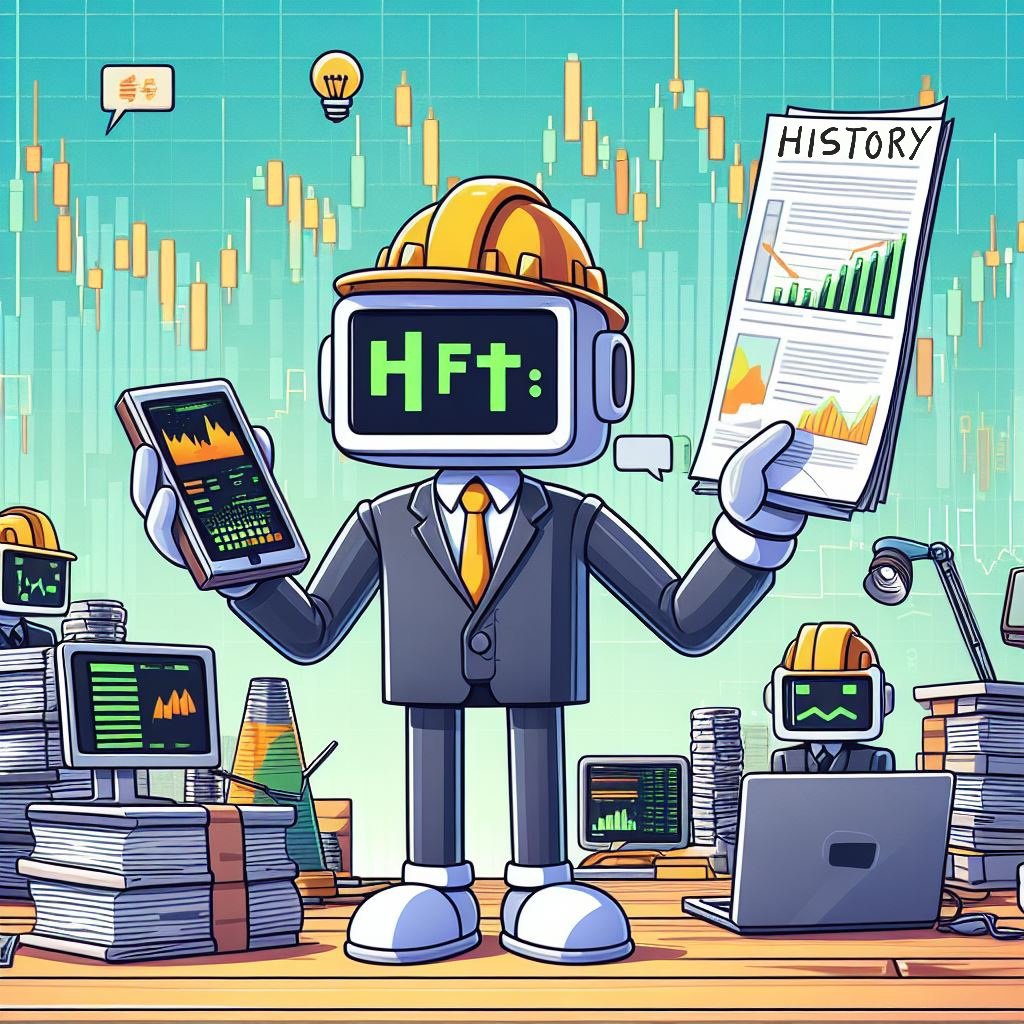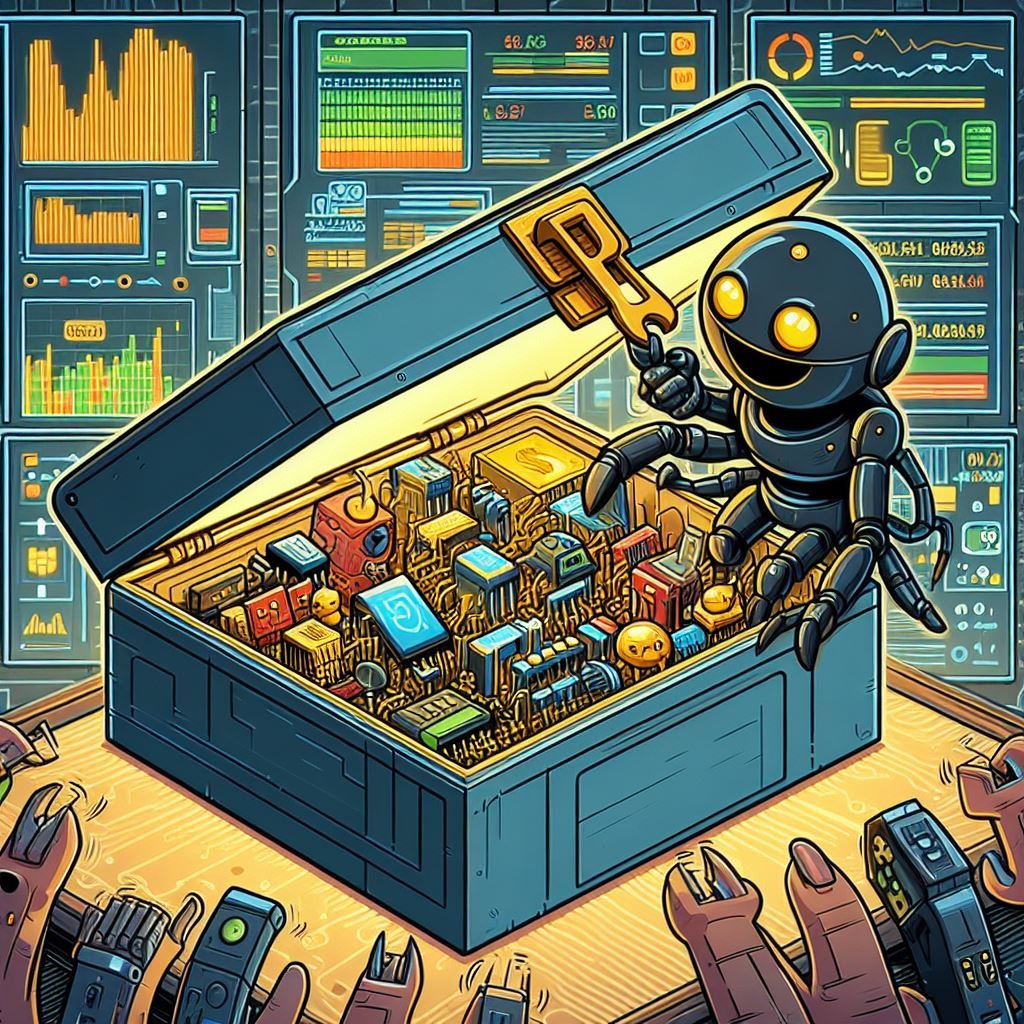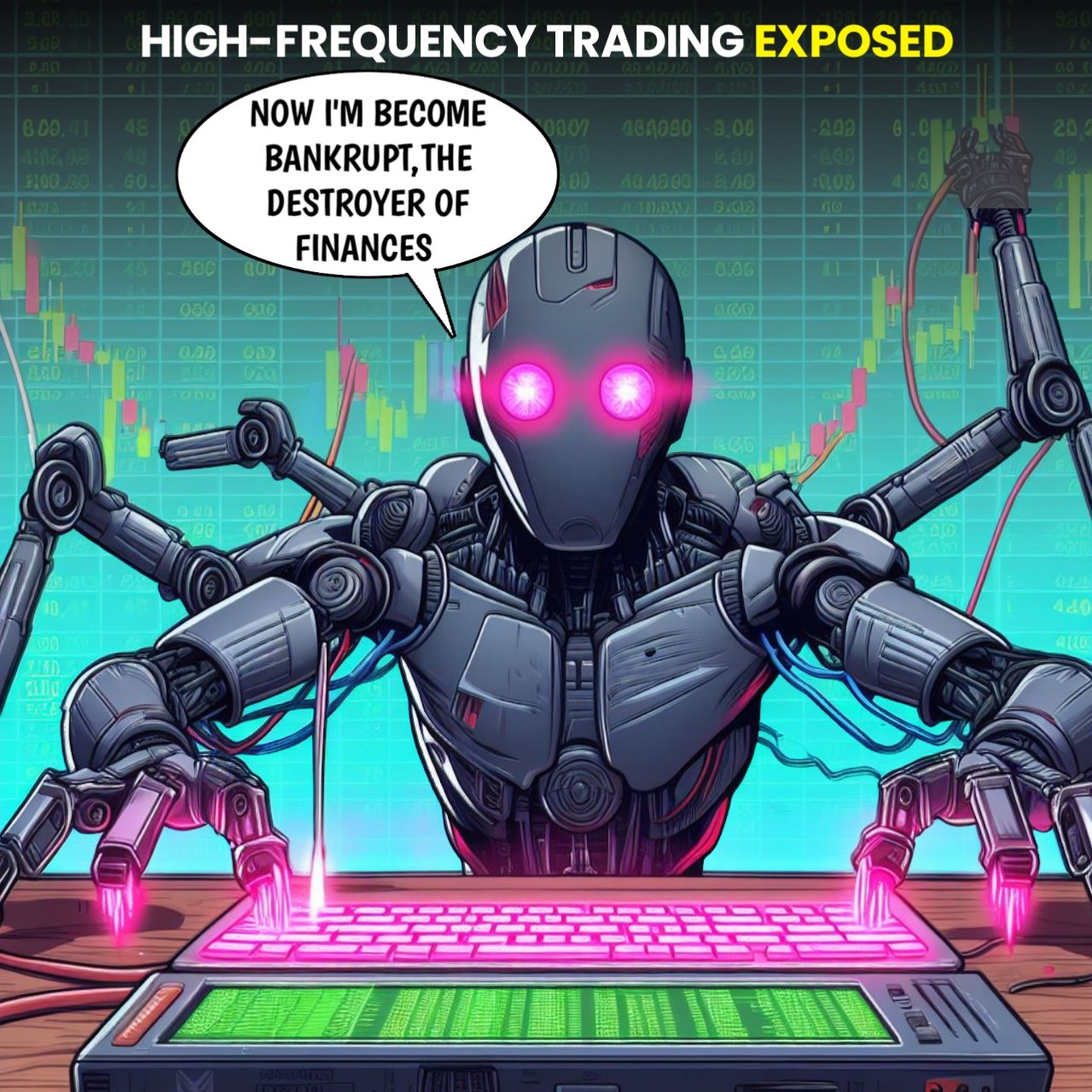High-Frequency Trading Exposed: Are Robots Rigging the Market Against YOU?
High-frequency trading (HFT) has turned the markets into an unequal game, involving the involvement of algorithms and technical wizards. You put your hard-earned savings into the market, carefully choosing stocks you believe in, only to watch them inexplicably fall. You refresh your screen, heart beating faster, but the numbers mock you. The question arises, is it just bad luck, or are you being messed with? Meanwhile, with the lack of fairness and transparency, investors’ hopes of winning in this rigged game are questioned.
But the interesting thing is that no one is talking about it. Financial elites whisper in hushed tones about the dominance of High-Frequency Trading, while regulators toy with outdated rules. Meanwhile, your Retirement fund is dwindling, which bodes poorly for your dreams of financial security.
The web of High-Frequency Trading has reached every corner of the market, affecting the price of everything from your morning coffee to the next big tech IPO. In this fair and transparent environment, does the average investor have any hope of winning in this rigged game?
Are robots attacking you in the market? We will analyze the algorithms of High-Frequency Trading and discuss strategies to efficiently arm investors to win in this wild ride game while uncovering hidden biases. Buckle up, because we’re about to unveil the High-Frequency Trading black box.
The Rise of the Robo-Traders
A Brief History of High-Frequency Trading

Remember the roaring twenties, when stockbrokers bellowed orders across bustling trading floors? Those days are about as quaint as dial-up internet. The modern market is a silent symphony of algorithms, where lightning-fast computers, not human shouts, dictate the rhythm of the day. And at the heart of this algorithmic revolution sits a controversial force: high-frequency trading (HFT).
But High-Frequency Trading didn’t appear overnight, like a rogue AI in a sci-fi flick. Its roots stretch back to the 1980s, when the Nasdaq became the first fully electronic exchange. This shift paved the way for programmatic trading, where computers started placing orders based on pre-defined rules. At first, these algorithms were like toddlers learning to walk, taking seconds to analyze and execute trades. But with each technological leap, they grew faster, smarter, and more ruthless.
By the early 2000s, High-Frequency Trading had evolved into a formidable beast. Armed with cutting-edge hardware and sophisticated software, algorithmic traders could analyze milliseconds of market data, exploit tiny price discrepancies, and execute trades in a blink – literally. Humans became spectators in their own market, watching profits slip through their fingers before they could even react.
The HFT Ecosystem
But who are these algorithmic predators? The High-Frequency Trading landscape is a diverse one, populated by:
- Hedge fund: A hedge fund is a financial scheme designed to avoid losses and keep investments safe. Its purpose is to widen the difference between the high and low prices of the market, allowing investors to profit using margin. Proprietary Trading Firm: Proprietary trading firm is a comprehensive financial institution that earns profits through various financial instruments. It invests for various financial purposes and remains active in the financial markets.
- Market Maker: Market maker is a broad term that refers to the person, organization, or means that introduces a good or service to the market. It is responsible for creating products or services and presenting them in the market. Market maker is usually related to entrepreneurship and marketing and has high efficiency and ability to invest in new marketing areas.
These players operate in a complex ecosystem, interconnected by high-speed trading networks and co-location facilities. Imagine data racing through fiber optic cables housed in temperature-controlled bunkers, mere nanoseconds closer to the exchange servers – that’s the world of High-Frequency Trading.
The Algorithm Speed, Precision, and Profits
So, what exactly makes High-Frequency Trading so powerful? It’s all about three key things:
- Speed: High-Frequency trading algorithms can analyze and execute trades in microseconds, far faster than any human eye can follow. This gives them a crucial head start in exploiting fleeting market inefficiencies.
- Precision: These algorithms are trained on vast amounts of market data, allowing them to identify microscopic price discrepancies and arbitrage them for profit.
- Volume: High-Frequency Trading firms place a massive volume of orders, accounting for a significant portion of daily trading activity. This sheer volume can amplify market movements and even trigger flash crashes.
How High-Frequency Trading Algorithms Work

In this we will open the black box of High-Frequency Trading algorithms and analyze their inner workings. Be prepared to be surprised, confused, and maybe a little nervous.
Front-Running and Latency Arbitrage

Imagine you’re driving, and suddenly, your map app informs you of a traffic jam ahead. You slow down, avoiding the chaos. Well, High-Frequency Trading algorithms are like advanced road warriors, able to predict market “traffic jams” before they even happen. How? Through two key strategies:
- Front-Running: This strategy is like cutting in line at a theme park. High-Frequency Trading algorithms analyze incoming orders, identifying large trades about to hit the market. They then place smaller orders ahead of them, hoping to profit from the subsequent price movement triggered by the bigger trade. Think of it as slipping through a tiny gap in the market crowd to grab the best seat before the show starts.
- Latency Arbitrage: Ever notice how some websites load faster than others? Latency arbitrage plays on similar principles. High-Frequency Trading algorithms leverage their physical proximity to exchange servers, gaining microsecond-fast advantages over slower traders. This allows them to exploit tiny price discrepancies between different exchanges before the information has time to propagate across the network. It’s like having a front-row seat at the stock market opera, hearing the music just a fraction of a second before everyone else.
These strategies may sound harmless, but they raise concerns about fairness. Are High-Frequency Trading firms essentially using their technological edge to peek at other players’ cards? Are they creating an uneven playing field where speed trumps skill? In the next section, we’ll explore the murky waters of flash trading and dark pools, where the real action (and controversy) happens.
Flash Trading and Dark Pools

Think of traditional stock exchanges as crowded marketplaces, bustling with buyers and sellers. Flash trading takes place in a back alley, a hidden network of private exchanges called dark pools. Here, trades are executed at lightning speed, invisible to the prying eyes of the public market. But why trade in the shadows?
Well, dark pools offer High-Frequency Trading algorithms a playground free from scrutiny. They can execute complex trading strategies without affecting the broader market, and their profits, well, let’s just say they can be eye-watering.
But the lack of transparency in dark pools comes at a cost. Flash crashes, sudden, dramatic drops in asset prices, have often been linked to High-Frequency Trading activity in these shadowy havens. The speed and opacity of these trades can amplify market volatility, creating unpredictable turbulence for everyone.
Can Algorithms be Unfair?
Remember those lines of code we mentioned earlier? Well, they’re not just neutral instructions. High-Frequency Trading algorithms are built by humans, and humans, as the saying goes, are fallible. This means our biases, however unintentional, can creep into the code, shaping how these algorithms interact with the market.
Here are some potential biases to be aware of:
• Speed Bias: Algorithms favor stocks that can be traded quickly, potentially neglecting smaller companies or long-term investments.
• Confirmation Bias: Algorithms trained on historical data might perpetuate past trends, overlooking market shifts or disruptive innovation.
• Herding Bias: If several algorithms start trading the same stock, they can create a self-fulfilling prophecy, driving the price up or down regardless of underlying fundamentals.
The Impact of High-Frequency Trading: Winners and Losers in the Algorithmic Age
Now you know their hidden dance between code and microseconds. So now, the question is big: has this algorithmic revolution made the markets a better place, or are we facing a technological dystopia where robots manipulate the game? Let’s find out the winners and losers in this new scenario.
Can High-Frequency Trading Trigger Meltdowns?
Imagine a rollercoaster, but one built by unpredictable code and fueled by fleeting market imbalances. That’s the potential downside of High-Frequency Trading. While proponents argue it increases market efficiency, its lightning-fast trading can also amplify volatility, leading to sudden, dramatic price swings known as flash crashes.
Recall the “flash crash” of 2010, during which the Dow Jones Industrial Average rapidly fell 777 points in a matter of minutes. A number of allegations have been leveled against high-frequency trading (HFT) algorithms, outlining their potential to trigger self-fulfilling prophecies and intensify market anxiety. Despite regulatory efforts to rein in inappropriate algorithmic actions, fears of a flash crash remain as a serious acknowledgment of the influence and vulnerability inherent in High-Frequency Trading-dominated markets.
The Shrinking Pool of Liquidity
One of High-Frequency Trading’s touted benefits is increased market liquidity. By constantly placing and canceling orders, these algorithms create a bustling marketplace, seemingly offering investors easy entry and exit. However, critics argue this “ghost liquidity” is deceptive. Many High-Frequency Trading trades are fleeting, never actually resulting in ownership of the underlying asset. This can lead to a phenomenon called price impact, where small orders can disproportionately move the price due to a lack of genuine buying or selling pressure.
For long-term investors, navigating this volatile and often illiquid market can be challenging. Finding true price discovery, the point where the market accurately reflects an asset’s value, becomes increasingly difficult when prices are constantly bouncing under the influence of algorithmic skirmishes.
Is the Average Investor Doomed? Can You Beat the Machines?
Faced with the dominance of HFT algorithms, a feeling of helplessness may begin to emerge. Can an ordinary person armed with only a laptop and a cup of coffee realistically compete against these digital predators? Fortunately, the reaction is not complete surrender. Although HFT has undeniably changed the landscape, it has not made human intelligence irrelevant. Here are some approaches to navigating the maze of algorithms:
- Focus on long-term fundamentals: Ignore the noise of HFT and invest in companies with strong businesses and promising futures.
- Embrace diversification: Spread your risk across different asset classes and sectors to mitigate the impact of volatile algorithmic plays.
- Consider low-cost passive funds: Index funds track broad market movements, reducing exposure to individual HFT tactics.
- Stay informed: Educate yourself about HFT and its potential pitfalls to make informed investment decisions.
Tip – Knowledge is power. By understanding the limitations of HFT and employing sound investment principles, you can still carve your own path to success in this algorithmic era.
Regulating the Wild West: Can We Tame the HFT Beast?
We’ve explored the inner workings of HFT algorithms, witnessed their potential for both good and bad, and felt the tremors of algorithmic earthquakes in the market. Now, the question shifts: can we harness this technological force for good? Can we regulate the HFT Wild West before it plunges us into financial chaos?
The Challenges of Oversight

Imagine trying to herd a herd of gazelles on roller skates – that’s roughly the challenge of regulating HFT. These algorithms move at lightning speed, exploiting market inefficiencies in microseconds. By the time regulators even blink, the trade is done and dusted, leaving them chasing phantoms in a digital dust cloud.
The elusive nature of HFT strategies and the complex interconnectedness of trading networks further increase the complexity. Unraveling the intricacies of the code that controls these algorithms could be like decoding an extraterrestrial language, and identifying accountability for market disruptions within a web of interconnected firms like a needle in a haystack woven from fiber optic cables. is equivalent to finding out.
Existing Regulations and Proposed Reforms
Despite the challenges, regulators haven’t been entirely idle. Existing measures like circuit breakers, designed to halt trading during sudden plunges, and tick size increments, aiming to curb high-frequency churn, offer some level of control. However, critics argue these regulations are like trying to swat flies with a sledgehammer – often too blunt and lagging behind the ever-evolving tactics of HFT algorithms.
Proposed reforms aim to tackle specific concerns:
- Transaction taxes: A levy on individual trades could disincentivize high-frequency churn and encourage longer-term investment.
- Dark pool regulation: Increased transparency and oversight of these shadowy exchanges could shed light on HFT activity and mitigate potential systemic risks.
- Algorithmic auditing: Requiring firms to disclose their trading algorithms could help regulators identify harmful biases and prevent market manipulation.
A Look at Potential Solutions
The quest for a level playing field in the algorithmic era requires a multi-pronged approach:
- International cooperation: HFT operates globally, so coordinated efforts between regulators across different countries are crucial to prevent regulatory arbitrage and ensure effective oversight.
- Investing in technology: Regulators need the tools and resources to keep pace with the ever-evolving landscape of HFT. This includes advanced data analytics capabilities and expertise in algorithmic coding.
- Empowering retail investors: Providing educational resources and access to transparent market data can help individuals make informed investment decisions and protect themselves from potential abuses.
Taming the HFT beast is not about stifling innovation. It’s about ensuring a fair and efficient market where both human ingenuity and algorithmic power can co-exist for the benefit of all participants.
The Future of Markets
We stand at a crossroads in the financial landscape. HFT, the robotic beast, has reshaped the market, leaving us with a fundamental question: does the future belong to human traders navigating by compass, or will algorithms chart the course with cold, digital logic? Let’s explore the possibilities of a market where humans and machines coexist.
Man vs. Machine: Can We Coexist in the Algorithmic Age?
Some foresee a future marred by dystopian visions where faceless algorithms dominate, pushing human traders to the sidelines. On the contrary, others envision a utopian landscape where machines optimize every trade, ushering in an era of unparalleled efficiency and prosperity.
Fortunately, the reality is likely more nuanced. HFT undoubtedly brings advantages such as unmatched speed, heightened liquidity, and continuous market access. However, these advantages come with trade-offs, including increased volatility, opacity, and the potential for biases.
The key lies in establishing a symbiotic relationship, a balanced coexistence where humans and machines leverage their respective strengths. Humans, utilizing intuition, strategic thinking, and a long-term vision, can steer the development and application of HFT algorithms, ensuring they contribute to the collective good rather than accentuating disparities.
Towards a More Transparent and Equitable System: Building Trust in the Digital Age
To achieve this equilibrium, several crucial steps are needed:
- Enhanced transparency: Demystifying algorithms, making their logic and potential biases understandable to investors, is key to building trust. This could involve standardized reporting requirements for HFT firms and regular audits of their trading practices.
- Promoting financial literacy: Equipping individuals with the knowledge and skills to navigate the algorithmic landscape is vital. Educational initiatives focused on understanding HFT and making informed investment decisions are crucial to empower retail investors.
- Addressing systemic risks: Regulators must stay ahead of the curve, adapting to the evolving tactics of HFT and implementing safeguards against flash crashes and market manipulation. This requires continuous research, collaboration with experts, and investment in cutting-edge technology.
Are You Ready for the Robot Revolution?
The robotic revolution is happening, not just in factories, but in the heart of the financial system. But it doesn’t have to be a revolution against humanity. We can choose to make it a collaborative evolution, where machines augment our intelligence and help us build a more fair and efficient market for all.
So, dear reader, as we step into this algorithmic future, remember: the choice is ours. We can embrace the challenge, learn to dance with the robots, and shape a market that benefits everyone – humans and machines alike. Are you ready?
The pursuit of a fair and equitable market is an ongoing adventure, presenting fresh challenges and opportunities regularly. Maintain your curiosity, stay well-informed, and, crucially, stay actively involved. Your voice, your understanding, and your engagement play pivotal roles in molding the trajectory of finance.
Conclusion
The world of finance stands at a pivotal juncture as the rise of High-Frequency Trading (HFT) reshapes the market landscape. The intricate dance between algorithms and microseconds has introduced both unprecedented opportunities and challenges. While HFT offers unparalleled speed, increased liquidity, and 24/7 market access, it also brings forth concerns of volatility, opacity, and potential biases. The symbiosis between humans and machines becomes the focal point in navigating this algorithmic era.
Human intuition, strategic thinking, and long-term vision can guide the ethical development and application of HFT algorithms, ensuring they serve the collective good. As we contemplate the future, a commitment to transparency, financial literacy, and vigilant regulatory oversight emerges as essential elements. Embracing the collaborative evolution of man and machine, we have the power to shape a market that benefits all participants.
Resources
Here are some useful Resources to deep dive in the world of HFT:
Books
Flash Boys: A Wall Street Revolt by Michael Lewis: An expose on the world of HFT and dark pools, exploring how high-speed traders exploit information advantages.
Algorithms to Live By: The Computer Science of Human Decisions by Brian Christian, Thomas L. Griffiths and Tom Griffiths: Explores how algorithms influence our everyday decisions, with insights into the potential biases and limitations of algorithmic trading.
Websites
- Securities and Exchange Commission (SEC) – High-Frequency Trading: https://www.fi-desk.com/sec-proposes-regulation-of-high-frequency-trading-firms-in-us-treasury-market/
- Financial Industry Regulatory Authority (FINRA) – Algorithmic Trading: https://www.finra.org/rules-guidance/key-topics/algorithmic-trading
- The Algorithmic Trading Review: https://blog.quantinsti.com/tag/quantra-reviews/
- Quantitative Finance: https://corporatefinanceinstitute.com/resources/data-science/quantitative-finance/

